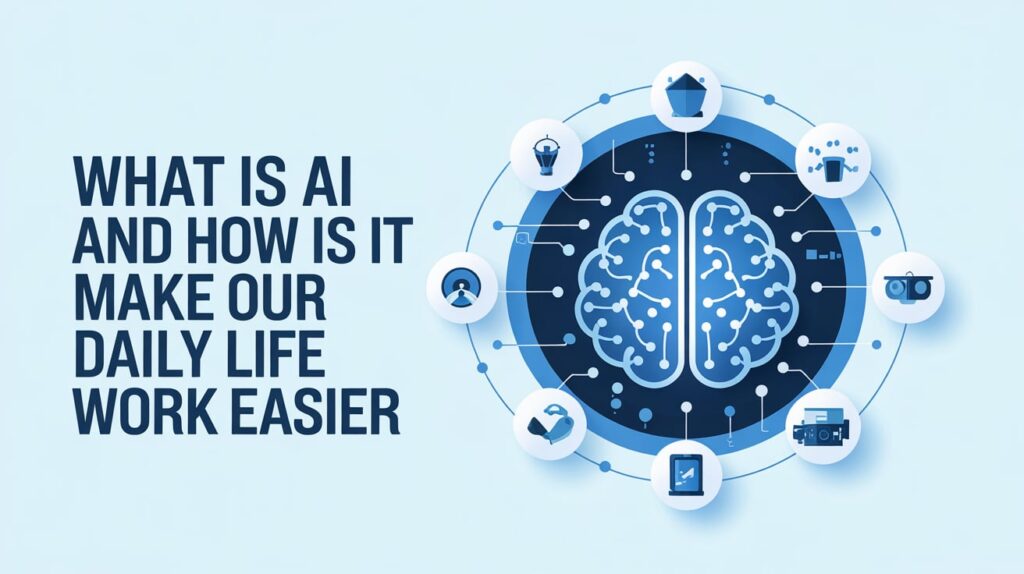Artificial Intelligence (AI) is no longer just a futuristic concept—it’s now a part of our everyday lives. From voice assistants like Siri and Alexa to recommendation systems on Netflix and Amazon, AI is transforming how we live, work, and interact with technology.
But what exactly is AI, and how does it simplify our daily tasks? In this blog post, we’ll explore:
✅ What AI is and how it works
✅ Real-life examples of AI in daily routines
✅ How AI improves productivity at work
✅ The future of AI and its impact on society
What Is Artificial Intelligence (AI)?
AI refers to computer systems that can perform tasks typically requiring human intelligence, such as:
- Learning (machine learning)
- Problem-solving (algorithms)
- Understanding language (natural language processing)
- Recognizing images & speech (computer vision)

Unlike traditional software, AI adapts and improves over time based on data.
Types of AI
- Narrow AI (Weak AI) – Designed for specific tasks (e.g., chatbots, facial recognition).
- General AI (Strong AI) – Hypothetical AI that can think like a human (still in research).
- Superintelligent AI – A future AI that surpasses human intelligence (still theoretical).
Most AI today is Narrow AI, but it’s already making a huge impact.
How AI Makes Daily Life Easier
1. Smart Assistants (Siri, Alexa, Google Assistant)
- What it does: Answers questions, sets reminders, controls smart home devices.
- How it helps: Hands-free convenience for busy schedules.
2. Personalized Recommendations (Netflix, Spotify, Amazon)
- What it does: Suggests movies, music, or products based on your preferences.
- How it helps: Saves time searching for what you like.
3. AI in Healthcare (Diagnosis & Wearables)
- What it does:
- Analyzes medical scans (X-rays, MRIs) for faster diagnosis.
- Tracks health metrics via smartwatches (e.g., heart rate, sleep patterns).
- How it helps: Early detection of health issues and better personal wellness.
4. Navigation & Traffic Predictions (Google Maps, Waze)
- What it does: Optimizes routes using real-time traffic data.
- How it helps: Reduces commute time and fuel consumption.
5. Fraud Detection in Banking (AI-Powered Security)
- What it does: Flags suspicious transactions instantly.
- How it helps: Protects against identity theft and financial scams.
6. AI in Smart Homes (Thermostats, Lights, Security)
- What it does: Learns your habits to automate lighting, heating, and security.
- How it helps: Saves energy and enhances home safety.

How AI Improves Work Productivity
1. Automation of Repetitive Tasks
- Example: AI-powered tools like Zapier automate data entry between apps.
- Benefit: Frees up time for creative and strategic work.
2. AI-Powered Customer Support (Chatbots)
- Example: ChatGPT-powered chatbots handle FAQs 24/7.
- Benefit: Reduces response time and improves customer satisfaction.
3. Enhanced Data Analysis & Decision-Making
- Example: AI tools like Tableau analyze trends in seconds.
- Benefit: Faster, data-driven business decisions.
4. AI in Recruitment (Resume Screening & Interviews)
- Example: Tools like HireVue analyze candidate responses.
- Benefit: Reduces hiring bias and speeds up recruitment.
5. AI-Generated Content (Writing, Design, Coding)
- Example: Tools like Grammarly, Canva AI, and GitHub Copilot.
- Benefit: Speeds up content creation and reduces errors.
The Future of AI: What’s Next?
AI is evolving rapidly, and future advancements could include:
🔹 Self-driving cars becoming mainstream.
🔹 AI doctors providing remote medical advice.
🔹 Hyper-personalized education with AI tutors.
🔹 Robotic assistants for elderly care.
However, challenges like job displacement, privacy concerns, and AI ethics must be addressed.

Final Thoughts: Embracing AI Wisely
AI is not here to replace humans—it’s here to assist us in working smarter and living better. By understanding and leveraging AI tools, we can:
✅ Save time on mundane tasks.
✅ Make better decisions with data insights.
✅ Improve efficiency in both personal and professional life.
The key is to stay informed, adapt, and use AI responsibly.
What’s Your Favorite AI Tool?
Do you use AI daily? Share your favorite AI-powered apps in the comments! 🚀


1 thought on “What Is AI and How Does It Make Our Daily Life & Work Easier?”